Rona Berg, a peripatetic but New York based writer and editor, has published a personal, in-depth piece on A Good Dish in Organic Spa Magazine. It includes an interview with me and 2 recipes from the blog. Here is the link:
making food simpler
Rona Berg, a peripatetic but New York based writer and editor, has published a personal, in-depth piece on A Good Dish in Organic Spa Magazine. It includes an interview with me and 2 recipes from the blog. Here is the link:
Doesn’t September alway feel like a fresh start?



A Labor Day picnic is a way to use up the contents of your produce drawer and have a lovely late summer meal outdoors. Whether you box it all up to transport to a park or beach or plate it to serve in your yard, a picnic is a fun, easy and festive way to eat on a day when we take off from our ordinary labor. Picnics often involve less complicated foods and certainly less dishes to do! When our son was young, we would picnic at a nearby playground with other families on warm summer nights. The kids could run around and we got a break from the kitchen and time to chat with other parents. Now we are more likely to take a picnic when we go to hear music outdoors and almost always when taking the train or flying somewhere.
Picnic food has certain requirements – no mayo (or other ingredients that go bad from sitting out for a while), ease of eating (often to be picked up in the hands or off paper plates) and easily transported. I usually think of Italian antipasto when composing a picnic – if food can sit out on a buffet table for hours, it will probably be fine in a cooler or picnic basket. I try, whenever possible, not to use plastic containers so for picnicking or lunch boxes, I use glass or stainless steel boxes. I know everyone is not so persnickety. Even deli sandwiches or containers of salad bar takeout provide the makings for an improvised picnic.
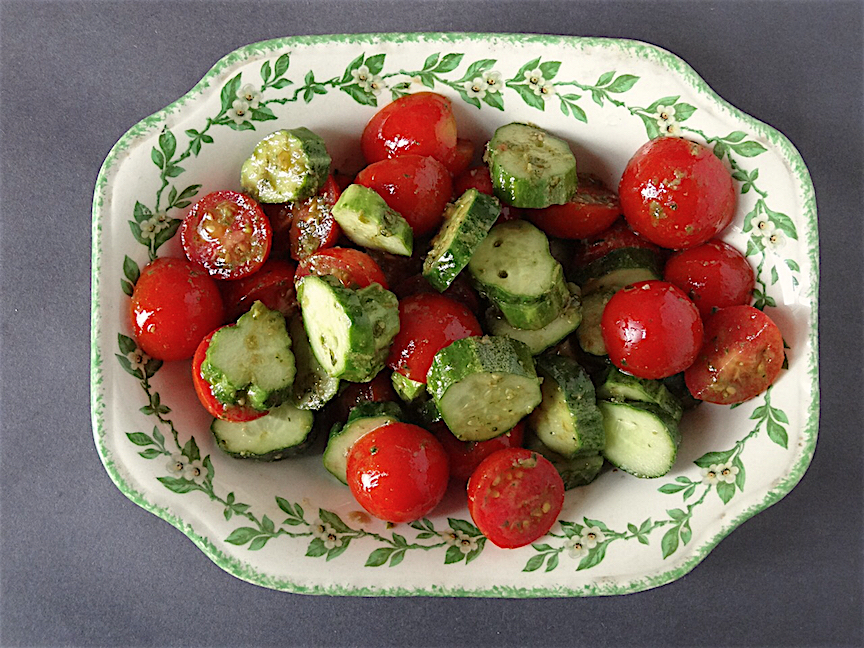
All kinds of simple foods work on a picnic – cheeses, salami or other dried sausages, olives, nuts, sandwiches without mayonnaise, rice, pasta, and bean salads with oil based dressings, whole, sliced or cut up fruit (peaches, figs and watermelon are perfect right now), cleaned and cut raw vegetables like carrots, celery, peppers, jicama, cucumbers and cherry tomatoes). With just a bit more effort you can include cooked vegetable salads (like broccoli, cauliflower, roasted peppers, corn or summer squash) with vinaigrette and even cooked chicken, ham or bacon, smoked or cold, poached fish, canned tuna or salmon prepared with oil or mustard and even a frittata can hold up to jostling and temperature fluctuations if you are careful about sauces and timing and carry some cold packs.
My favorite picnic food is pesto. It’s great on pasta, beans, rice, baked or fried tempeh and tofu, chicken, fish or lightly cooked vegetables and doesn’t spoil easily. The traditional basil is my fallback but there are terrific versions made with arugula, kale, parsley and even Swiss chard. You can make it with or without cheese and even without nuts, black pepper or garlic, if you can’t eat or don’t like them. Just make sure to wash and dry your greens before blending and add plenty of fresh olive oil and salt which help preserve the greens. I use a food processor but you could make this with a mortar and pestle or in a strong blender.
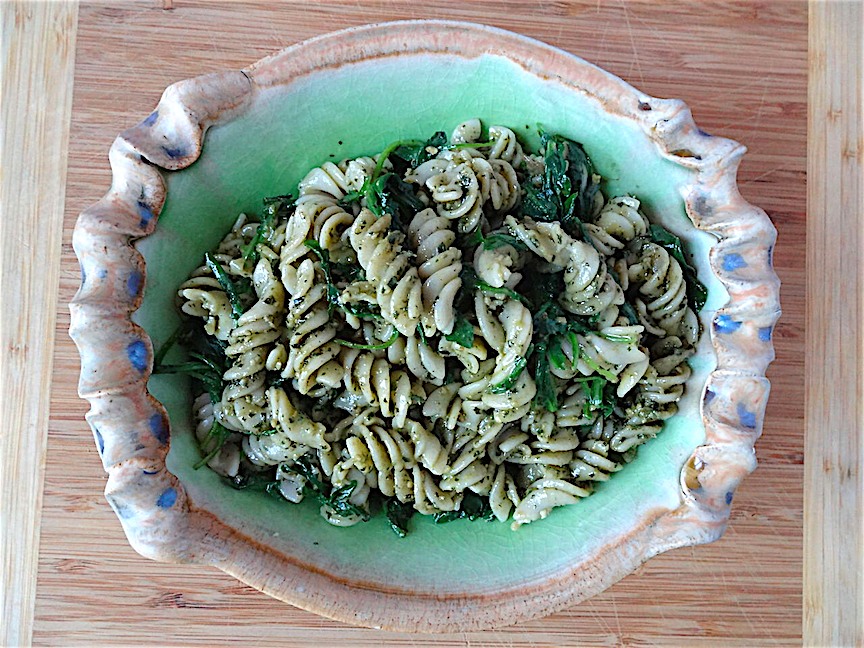
So head out to a park or the beach, hiking or boating, your deck, porch or yard while the weather is mild and bring a meal with you – it’s easy to prepare ahead and you won’t spend your day off concerned with meal planning. If, by chance it rains, spread your tablecloth or blanket on the floor and invent a pretend outing. I once planned a birthday picnic in Riverside park but when it rained, everyone just brought their fixings to our apartment and we had a wonderful indoor celebration. You can picnic anywhere. Don’t forget lots of water and lemonade, beer, wine and/or a thermos of your favorite concoction to add to the festive feeling. Happy outings!
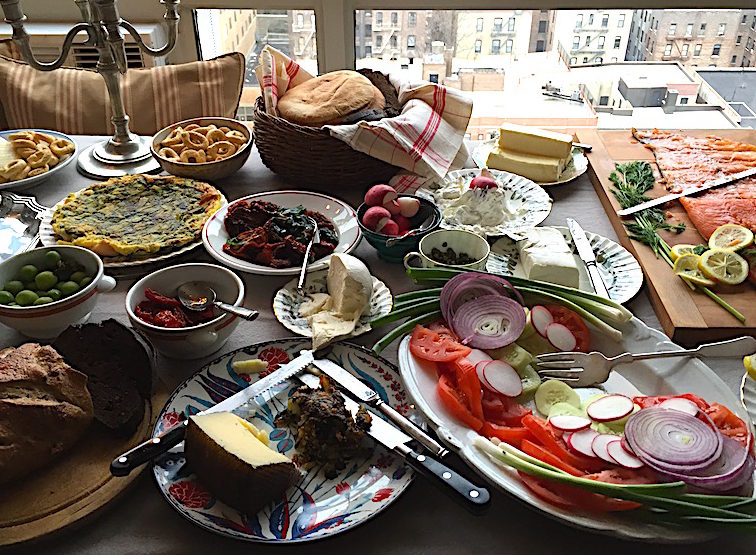
PRETTY TRADITIONAL BUT DELICIOUS BASIL PESTO
Put garlic in processor and pulse until finely ground. Add basil and any other green, if using, salt and pepper and process until all well mixed and leaves are all ground. Add nuts and cheese, if using, and pulse until ground and combined. Stop and scrape down sides. Stream in the oil while the motor is running. Stop and scrape down sides and see if it needs more seasoning or oil to reach a smooth consistency.
Use right away, thinned with a little (a couple of TBs) cooking water from pasta, rice or vegetables, to toss with pasta, rice, vegetables, cut up chicken or cooked beans (cannellini or great northern work well but so do many other types). Grate in a little lemon zest or squeeze in a little lemon juice for a fresh taste or add a pinch of cayenne or crushed chilies for heat. If using the salad for a picnic, cool in the refrigerator for a few hours or overnight. Pesto keeps well in the fridge for weeks with a thin coating of oil on top or in the freezer for months.
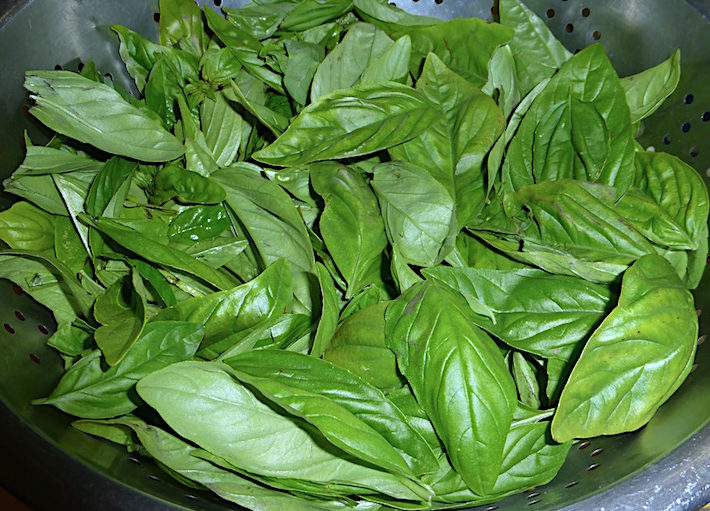
PESTO VINAIGRETTE
Shake or whisk until well blended:
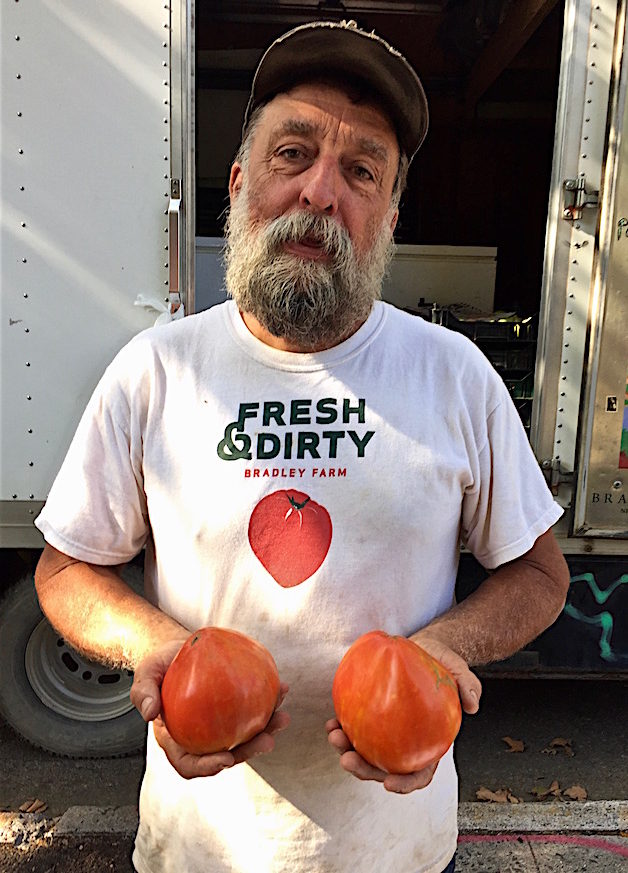
Tomatoes are ripe and tomatoes are Ray Bradley’s specialty. According to Bradley, the New Paltz chef turned farmer who grows and sells many different vegetables throughout the year, heirloom tomatoes are his favorites. Bradley farms because he loves to eat and cook what he raises. As it turns out, tomatoes, with their short season, have become a primary cash crop.
One of the best things about shopping at a local Farmers’ market, besides all of the fresh, organic and flavorful vegetables, is talking with the people who grow that food. Each one has a back story, none more compelling and meandering through the food world than Ray Bradley. With a cooking background that ranges from Cape Cod, Shelter Island, Florida and Costa Rica and includes stints at Le Cirque, Montrachet and Bouley in Manhattan, he moved into farming in order to grow his own organic vegetables. The full bearded, hardworking Bradley drives from his upstate farm to the 97th Street Market in Manhattan on Fridays during the summer and fall and to the Grand Army Plaza Market, in Brooklyn, on Saturdays year round.

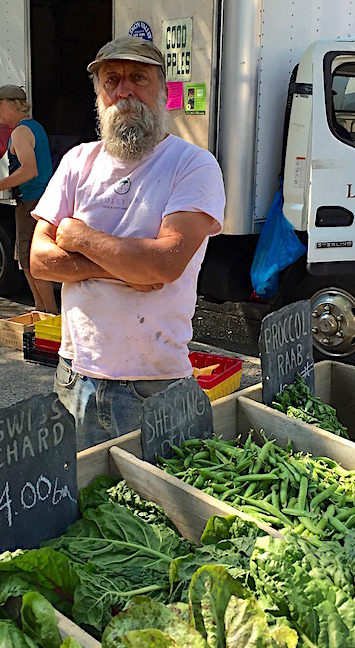
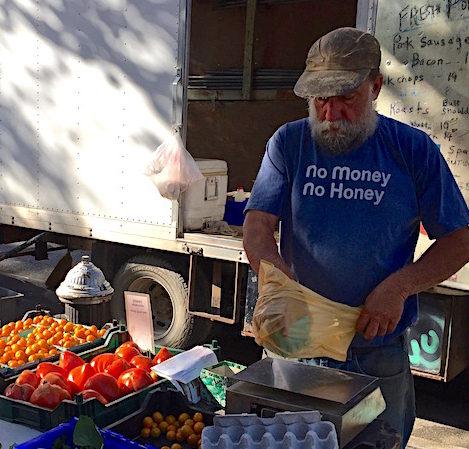
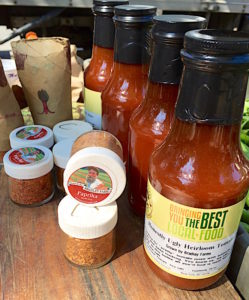
The life of a farmer is fraught with difficulty and Bradley’s plight has been no different. He has had floods and droughts, pests and plant diseases but the good years seem to outweigh the bad, overall, he says. In order to bring in more income, Bradley has been an innovator with products – he makes and sells his own paprika and tomato juice – and events. His farm is now known for its on-site, guest chef cooked dinners, often with wine pairings, pizza or grill parties showcasing his farm products, including farm grown salads and his own pork, beer and spirit tastings featuring his own farmhouse ale, as well as a farm stand. Just last week, he hosted a BLT and beer afternoon to celebrate the tomato harvest and his just-smoked bacon. Currently, he is running a raffle to raise money to build an outdoor wood-burning oven to expand his on-farm cooking possibilities.
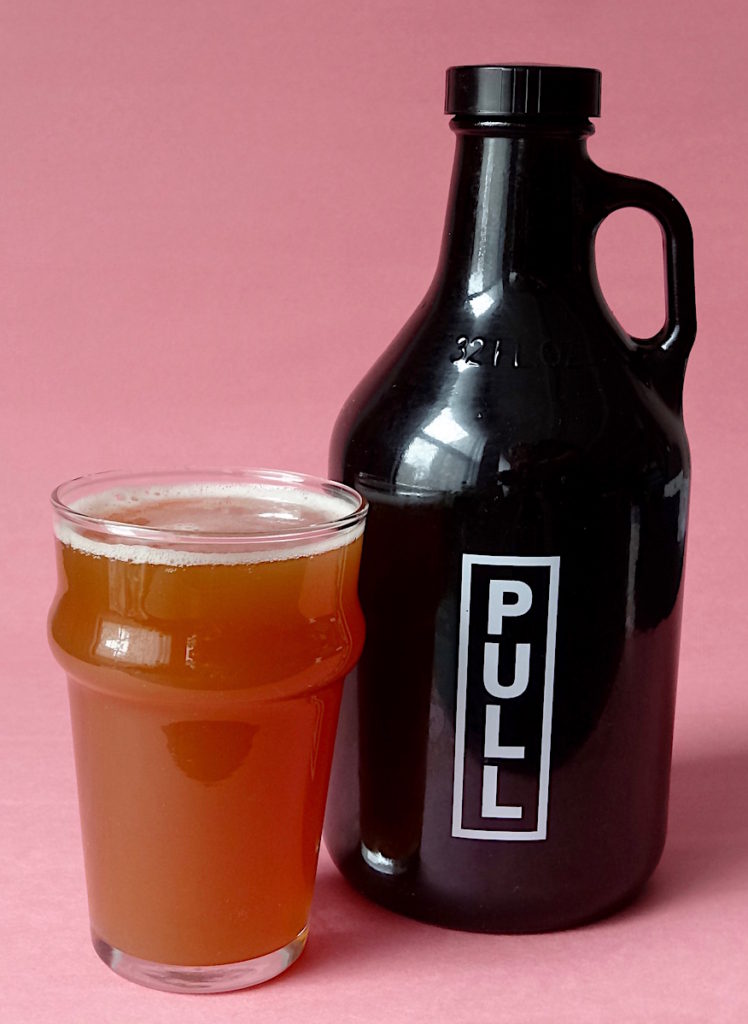
Bradley grows and sells the usual vegetables – broccoli, lettuces, onions, zucchini, peas, beets, parsley, potatoes and cabbage – that you see at most farm stands, although with Bradley, the varieties are specific to his tastes. The only potato he grows, for example, is the Carola, a small yellow-fleshed type, because that is his favorite. But, perhaps as a result of his culinary experience, he also grows a wide variety of less ordinary crops – flat Italian pole beans, fennel replete with fronds, French gray shallots, haricot vert (those delicious skinny green beans), sweet delicata and buttercup squash, fava beans, bush basil (tiny, spicier leaves), sorrel and purslane, a small-leafed lemony green. But his best sellers, by far, are his heirloom tomatoes, which range in size from tiny and round to huge and rippled, and in color from pale green to orange to red to purple.
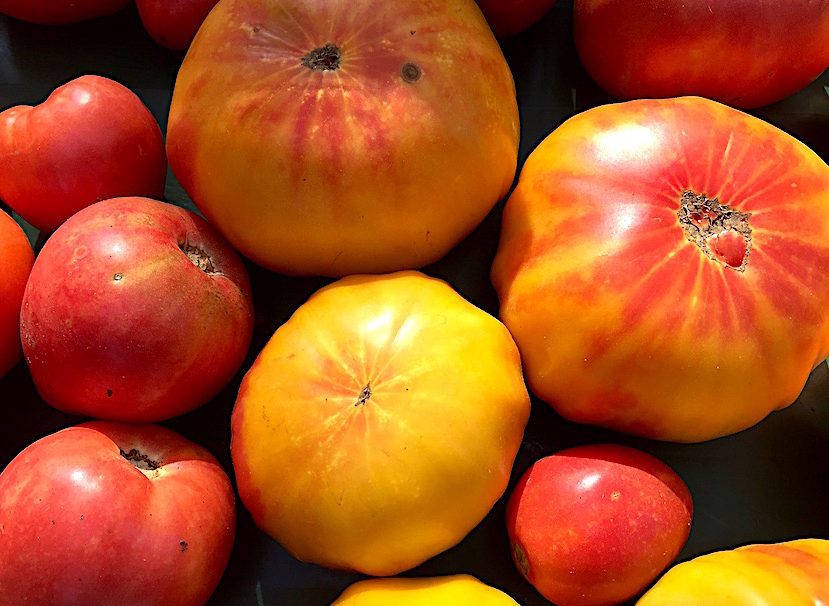
Whether oblong or circular, Bradley’s heirlooms are full of flavor. He credits this to both the quality of seeds and soil and the way he raises them. He plants the seeds he saved from the previous year’s crop (when he finds a particularly good tasting tomato, he dries and saves those seeds) in April. By May, once any chance of frost has passed, he is transplanting small seedlings into the ground to give them the best chance of putting down good roots. Besides starting with good seeds and amending what was good soil to start with, perhaps the main reason his tomatoes are so flavorful is that he doesn’t water them – he says that is what develops the intensity of flavor. Whatever the cause, the tomatoes are delicious – we’ve been eating lots of them with just a simple vinaigrette and sprinkle of fresh basil or oregano. Bradley eschews vinaigrette, preferring not to mask the taste of his tomatoes. When we eat his heirlooms mixed or side by side with other tomatoes, the difference in flavor is obvious and the Bradley’s win every time.
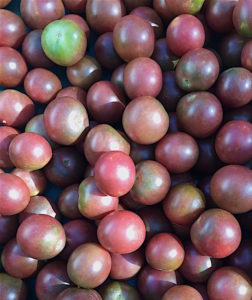
Besides heirlooms, Bradley grows more ordinary cooking, husk and cherry tomatoes. It’s hard to stop eating the small yellow/orange or red/green cherries from Bradley’s farm – they are sweet and addictive and I rarely get them into a salad because we devour them straight out of the paper bag. Bradley says he uses a tomato peeler with a serrated blade to peel the large tomatoes which he then freezes so he can make fresh sauce during the winter, although sometimes he just tosses them into the freezer whole. When the weather is cool enough, as it is this week, he can make sauce to use in cooking once the season has passed. That way, he can have fresh tomato flavor throughout the year. After all, the reason Bradley grows these gorgeous tomatoes in the first place is because he loves to eat them. Lucky for us!

RAY BRADLEY’S TOMATO SAUCE
Preheat your oven to 400F.
Score (cut an x) whole tomatoes with a sharp knife.
Place on a rimmed baking sheet and drizzle with olive oil and sprinkle with salt and pepper.
Roast until skin is peeling off.
Remove skins and put in a pot with some sautéed onions and garlic.
Simmer until they begin to break down.
Cool and put up in glass containers.
Ray suggests sautéing a little onion and garlic and adding the sauce to them to re-heat when ready to use.
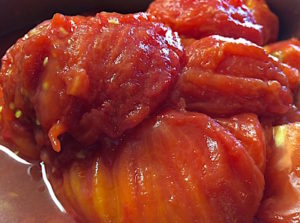
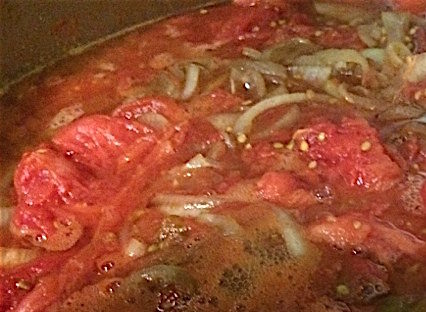
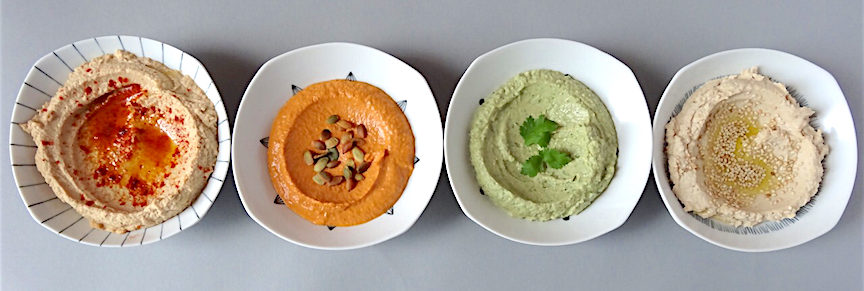
I am not going to turn on the oven or the stove – just not going to do it. With another week of over 90F and humid, with the heat index over 100, I am not going to add to the temperature in the kitchen. But we still need to eat, so I have to prepare meals without straining the groaning AC any more than I am already. And in this kind of weather, we all prefer a lighter meal.
In my mind, summer dinners should be fun, cooling and a bit hodgepodge. If you don’t have access to a grill, salads are a way to go. A few weeks ago, I shared the cucumber and pineapple salad with lime and mint that is fresh and zingy. And the tomato salads and variations (the caprese with mozzarella, the tomato and cuke with basil, the watermelon with feta, mint and lime) are another solution. Cold soup is one more direction, essentially being a liquid salad. Gazpacho, cold cucumber soup with yogurt or buttermilk or a fruit soup, like blueberry or melon are all light, cooling lunches or suppers. Or simply put out a cheese or charcuterie board with some fig jam or pepper jelly, nuts, cold grapes or sliced fruit and a green salad and be done.
One more idea, and one you probably already have in your fridge, is hummus. Boring, you are thinking? Doesn’t have to be. And doesn’t have to be served with pita or chips – carrots, celery, green and red pepper, cucumber, jicama and radishes all make excellent dipping vehicles and, when well arranged, make a lovely mezze platter. You can even start with store bought hummus and doctor it up, although homemade takes so very little time and effort it is really worth it – plus you know what is in it! Blend in avocado, pieces of black or green olives, jalapeños, roasted peppers, cooked beets or carrots, toasted walnuts, chopped chives, parsley or dill or, my favorite, smoked paprika. Pretty much anything goes. Lighten it all up by mixing in some plain yogurt or enrich it by drizzling with plain or chili infused olive oil. If you don’t eat legumes, make the recipe without the chickpeas only add a little less water and use it as a tahini dip.
The best hummus I ever ate was at Zahav, Michael Solomonov’s restaurant in Philadelphia. It was creamy, lemony and altogether full of sesame flavor. The recipe I have provided below is based on his, with a few modifications. If it were a cold weather month, I would cook my own chickpeas but with this heat, I am happy to use canned. Solomonov recommends Soom Tahini (sold on Amazon) but I’ve used a local brand (Sahadi from Brooklyn), Trader Joe’s (which happens to be organic) and several health food brands (all in glass, not a tin) with good results. Err on the side of more garlic, salt and lemon rather than too little and blend it all longer than you would think for super creaminess.
Plate your hummus in a beautiful shallow bowl (easier for dipping), drizzle with olive oil, sprinkle with paprika or sesame seeds and surround it generously with all kinds of colorful vegetables on a large platter or wooden board. To make a mezze platter, serve it with or without some stuffed grape leaves (as easy as opening a can), small bowls of olives, cherry tomatoes, those yummy peppadew or cherry peppers, sliced melon, tabbouleh or a parsley salad and an accompanying bread – focaccia, ciabatta, baguette or pita, or your favorite gluten-free crackers (try the Mary’s pretzel-like sticks with the hummus – very crunchy) – add a cold beer or glass of wine and dinner is served.
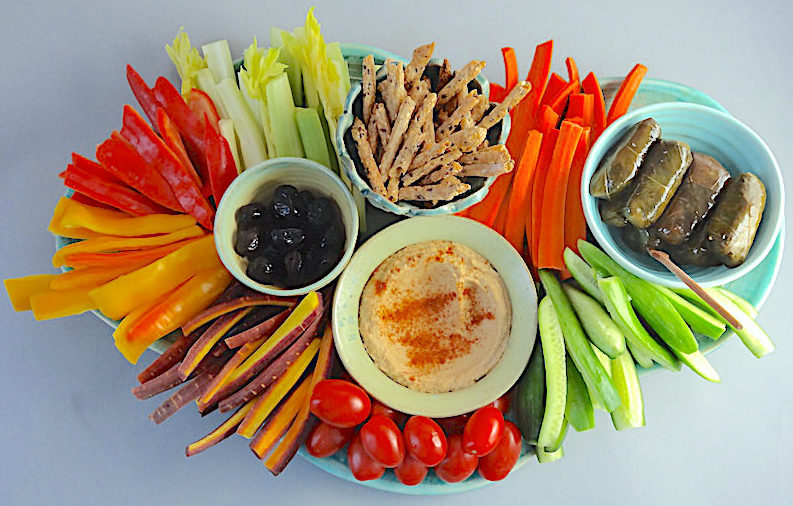
Homemade Hummus
1 can (15.5 oz.) organic chickpeas, rinsed and drained
1/2 cup tahini
2-3 garlic cloves
1/3 cup fresh lemon juice
1 heaping teaspoon kosher salt
1/2 tsp ground cumin
1/2 cup water or more, as needed
Combine garlic, salt and cumin and pulse until minced well.
Add lemon juice and pulse, then add tahini and pulse until it seizes up.
Add water, more if needed, and blend until smooth.
Add chickpeas and pulse until completely smooth.
Taste for seasoning and add more salt if you think it needs it – probably will.
Hummus keeps well for days in the refrigerator.
Optional add-ins:
1 tsp smoked paprika
1/4 cup toasted sesame seeds (reserve 1 tsp for sprinkling on top)
1-2 roasted red peppers (I use jarred)
2 green jalapeños and a big handful of cilantro with juice of 1/2 lime
1 roasted beet
1-2 TBs olive oil
1/2-1 cup plain yogurt
1/2-1 peeled and pitted avocado
1/2 cup black or green pitted olives
A handful of parsley and chives
1/2 cup sautéed onions or several cloves of roasted garlic
If you take out half of the hummus before putting in an add-in, you can make 2 flavors out of one recipe.
Whatever else you can imagine – hummus is a good vehicle for adding your favorite ingredient